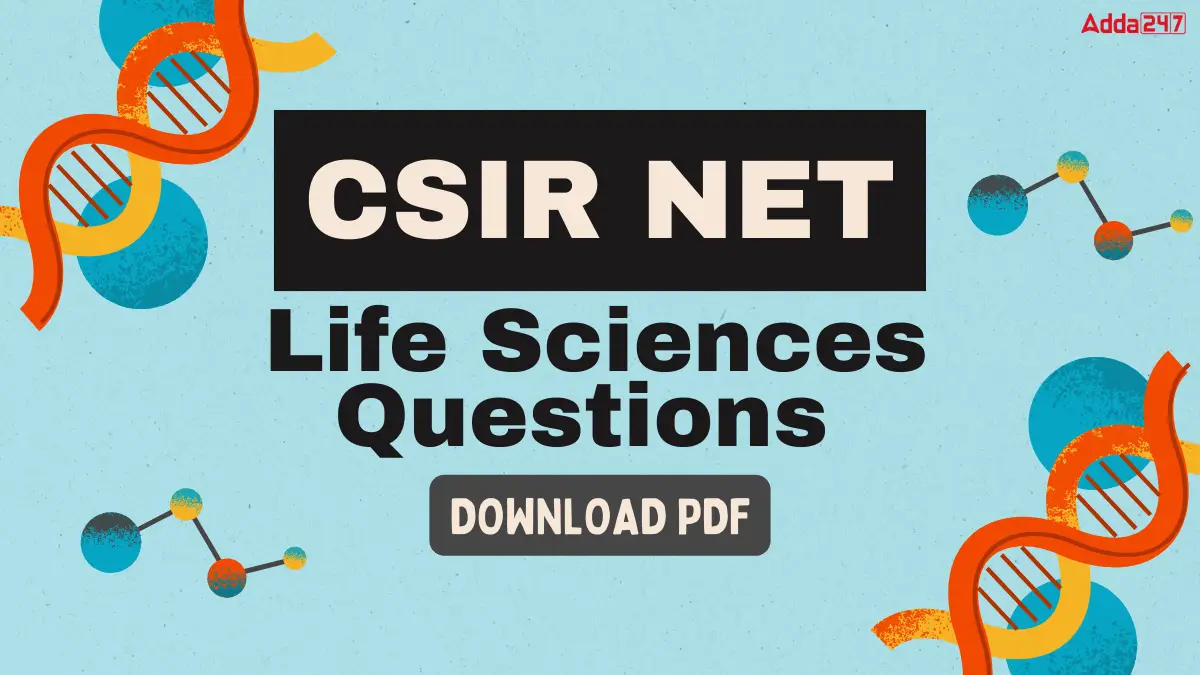Table of Contents
The Council of Scientific and Industrial Research National Eligibility Test (CSIR NET) stands as one of India’s most prestigious examinations for aspiring researchers and academicians. Serving as a critical benchmark, this competitive test determines eligibility for Junior Research Fellowships (JRF) and lectureship positions in universities and colleges nationwide. For candidates specializing in Life Sciences, comprehensive preparation is now made easier with access to CSIR NET Life Sciences questions accompanied by detailed solutions, carefully curated and provided below to enhance understanding and exam readiness.
CSIR NET Life Sciences Questions with Detailed Solutions
Preparing for the CSIR NET Life Sciences exam requires a deep understanding of the subject, along with practice through previous years’ questions and mock tests. Solving CSIR NET Life Sciences questions with detailed solutions helps candidates understand the exam pattern, identify important topics, and improve problem-solving skills. These solutions provide step-by-step explanations, making it easier for aspirants to grasp complex concepts and avoid common mistakes.
CSIR NET Life Sciences: Overview
The CSIR NET Life Sciences exam is a highly competitive test conducted to determine the eligibility of candidates for Junior Research Fellowships (JRF) and lectureship in Indian universities and colleges. CSIR NET exam evaluates candidates’ knowledge, analytical skills, and understanding of Life Sciences. The CSIR NET exam is divided into three parts. The total duration of the exam is 3 hours, and the maximum marks are 200. Below is a detailed overview of the exam pattern and mark distribution in a concise table format:
| Section | Details | Number of Questions | Questions to Attempt | Marks per Question | Total Marks | Negative Marking |
|---|---|---|---|---|---|---|
| Part A | General Aptitude (Reasoning, Analytical Skills, General Science Awareness) | 20 | 15 | 2 | 30 | -0.5 |
| Part B | Subject-related MCQs (Core Concepts of Life Sciences) | 50 | 35 | 2 | 70 | -0.5 |
| Part C | Higher-Value Questions (Application-based and Problem-solving) | 75 | 25 | 4 | 100 | -1 |
| Total | – | 145 | 75 | – | 200 | – |
Download 100 CSIR NET Life Sciences Questions with Detailed Solutions PDF
To aid your preparation, you can download 100 CSIR NET Life Sciences questions with detailed solutions in PDF format. By practicing these questions, you can strengthen your conceptual understanding, improve time management, and boost your confidence for the exam.
| CSIR NET Life Sciences Questions PDF | |
| Part | Download PDF |
| CSIR NET Life Sciences Questions – Part 1 | Download PDF |
| CSIR NET Life Sciences Questions – Part 2 | Download PDF |
| CSIR NET Life Sciences Questions – Part 3 | Download PDF |
| CSIR NET Life Sciences Questions – Part 4 | Download PDF |
CSIR NET Life Sciences Questions
Q1. Which one of the following enzymes does NOT catalyze the oxidation of a substrate by reducing the electron acceptor, NAD⁺?
(a) Lactate dehydrogenase
(b) Pyruvate dehydrogenase
(c) Succinate dehydrogenase
(d) Isocitrate dehydrogenase
Q2. The pH of endocytic vesicles is 5.2, and the pH of gastric juice is 2.0. The endocytic vesicle has a [H+]that is:
(a) 15.85 times lower than that of gastric juice.
(b) 0.1585 times lower than that of gastric juice.
(c) 158.5 times lower than that of gastric juice.
(d) 1585 times lower than that of gastric juice. .
Q3. One strand of a palindromic dsDNA is composed of 5′-CCGCGGCGG-3′. Which one of the following forms of nucleic acid structures will be adopted in water if sense and antisense strands are mixed in equal proportion followed by annealing?
(a) A-form of double-stranded nucleic acid
(b) B-form of double-stranded nucleic acid
(c) Z-form of double-stranded nucleic acid
(d) Both will remain as single strands
Q4. Which one of the following pairs of metabolic intermediates does NOT provide a backbone carbon skeleton for the synthesis of amino acids?
(a) Succinate and citrate
(b) 3-phosphoglycerate and phosphoenolpyruvate
(c) Ribose 5-phosphate and erythrose 4-phosphate
(d) α-ketoglutarate and oxaloacetate
Q5. Fifteen spontaneous Ara⁻ mutants of E. coli, unable to utilize arabinose as a sole carbon source at 42°C but able to utilize it at 30°C, were isolated. Based on the above information, which one of the following options represents the most likely type of the mutations?
(a) Deletions
(b) Inversions
(c) Frameshift mutations
(d) Mis-sense mutations
Q6. Which one of the following statements about the distribution of chromosomes within the interphase nucleus of a mammalian cell is correct?
(a) Chromosomes are randomly distributed within the nuclear volume.
(b) The gene-poor chromosomes tend to locate towards the nuclear envelope.
(c) The larger chromosomes tend to locate at the nuclear periphery.
(d) Centromeric regions of all the chromosomes tend to concentrate at the center of the nucleus.
Q7. Which cell cycle phase is typically the shortest in mammalian cells?
(a) G0 phase
(b) G1 phase
(c) G2 phase
(d) Mitosis
Q8. Porins, which are normally present on the outer mitochondrial membrane, reach their destination by:
(a) Direct synthesis of porins on the mitochondrial membrane by the mitochondrial protein synthesis machinery.
(b) Synthesis on the ER and transport via vesicles to the mitochondria.
(c) Synthesis in the cytosol, import by TOM complex, and insertion from the inter-mitochondrial membrane space.
(d) Synthesis in the cytosol, import by TIM complex, and insertion in the membrane.
Q9. During replication, over-winding of DNA is caused by ____ and removed by ____:
(a) Primase, topoisomerase
(b) Primase, single-stranded binding protein
(c) Helicase, gyrase
(d) Helicase, DNA polymerase
Q10. P-bodies are discrete cytoplasmic collections of RNAs and proteins that are involved in:
(a) Deadenylation, decapping, and mRNA degradation
(b) Deadenylation and mRNA degradation only
(c) Deadenylation and decapping only
(d) Decapping and mRNA degradation only
Solutions
S1. Ans. (c)
S2. Ans. (d)
S3. Ans. (b)
S4. Ans. (a)
S5. Ans. (d)
S6. Ans. (b)
S7. Ans. (d)
S8. Ans.(c)
S9. Ans. (c)
S10. Ans.(a)
Benefits of CSIR NET Life Sciences Questions
- Improved understanding: Detailed explanations enhance your grasp of the subject matter and help you connect different concepts.
- Enhanced problem-solving skills: Working through solutions exposes you to different problem-solving approaches and helps you develop your own strategies.
- Better time management: Practicing with previous year’s papers under timed conditions helps you improve your speed and accuracy.
- Increased confidence: Solving a variety of questions and understanding the solutions boosts your confidence and reduces exam anxiety.




 Last Minute Preparation Tips for MP TET ...
Last Minute Preparation Tips for MP TET ...
 TS TET Application Form 2025 Out, Direct...
TS TET Application Form 2025 Out, Direct...
 Preparation Strategy to Crack DBT BET 20...
Preparation Strategy to Crack DBT BET 20...




